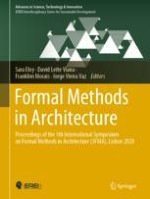
2021 | OriginalPaper | Buchkapitel
Mathematically Developing Building Facades: An Algorithmic Framework
verfasst von : Inês Caetano, António Leitão
Erschienen in: Formal Methods in Architecture
Aktivieren Sie unsere intelligente Suche, um passende Fachinhalte oder Patente zu finden.
Wählen Sie Textabschnitte aus um mit Künstlicher Intelligenz passenden Patente zu finden. powered by
Markieren Sie Textabschnitte, um KI-gestützt weitere passende Inhalte zu finden. powered by